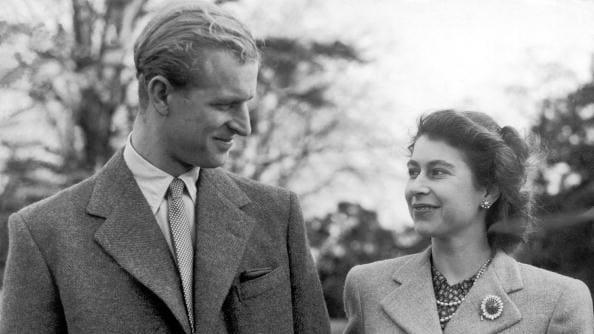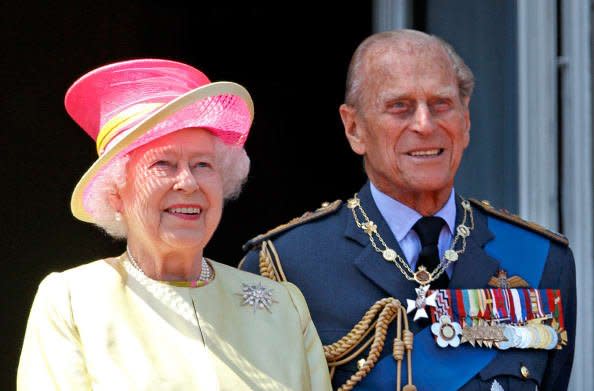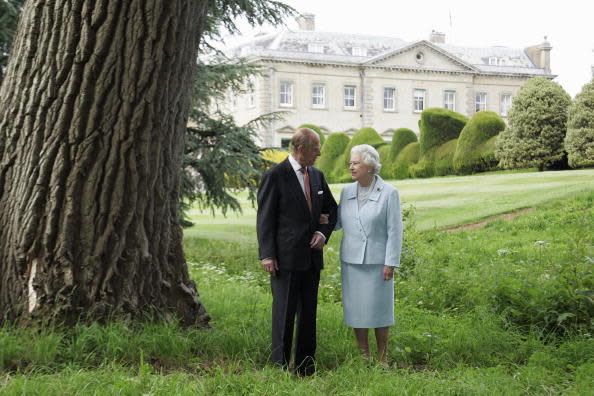How Prince Philip and the Queen Fell in Love, All According to Plan
- Oops!Something went wrong.Please try again later.
- Oops!Something went wrong.Please try again later.
- Oops!Something went wrong.Please try again later.

The start of a world war was only two months away. Yet the setting could not have been better imagined in a pulp romance as the spark of a great love unclouded by horrors to come.
It was July 1939. In Dartmouth Bay, southern England, the royal yacht dropped anchor. Aboard were the king, George VI, Queen Elizabeth, and their two daughters, Elizabeth and Margaret.
Will the Royals Let the Queen and Prince Philip Have a Peaceful Vacation?
Like his father, the king was a naval man. Of the three services, the Royal Navy was regarded as upper crust, referred to as the senior service. The royal family was paying a visit to the Royal Naval College at Dartmouth, where many of the cadets were drawn from aristocratic families.
On that day, one of the cadets had been singled out to meet the king, although his background was far from conventional—he had blue blood but was something of a stray dog who had been taken in from Europe and raised by an English foster family.
This was, in fact, the day when Lilibet met Philip—Lilibet being the family’s name for Princess Elizabeth and Philip being the cadet, Prince Philip of Greece. She was 13, he was 18.
Philip was assigned to escort the royal family on their tour of the college, and on the following day, he was invited to have tea with them.
When the royal yacht departed, it was escorted from the bay by a small fleet of sailboats, motorboats, and some single cadets rowing in skiffs—Philip, it is said, was one of these and the last to obey the signal to turn back.
Several accounts suggest that Elizabeth was smitten at first sight. Philip was certainly a flaxen-haired Adonis already well aware of his romantic appeal.
But this was clearly one of those meetings of destiny that get inflated by recollection and turn seamlessly into something suspiciously like a fairytale, and in a family where the fairytales don’t usually end well. This one, however, is the origin story of the royal marriage that famously endured for more than 73 years.
Bridging the gulf
In truth it was by no means a foregone conclusion that a successful courtship would follow. In terms of life knowledge and experience, there was, at the start, a great gulf between them. Philip was worldly in the broadest sense of the word and Elizabeth had led a very sheltered and unworldly life.
There were many in the royal court who thought Philip was a dangerous choice and for years opposed the idea of a marriage.
The one person who was determined that the marriage would happen was the man who had arranged the Dartmouth encounter in the first place, Philip’s uncle Louis Mountbatten, who was also his surrogate father.
Philip arrived in England in 1930. At the age of 9, he was a refugee from the collapse of the Greek monarchy. His father, Prince Andrew of Greece and Denmark, ended up living with a mistress in Monte Carlo while his mother, Princess Alice, after being diagnosed with schizophrenia and spending time in a Swiss sanatorium, took up holy orders and lived as an aesthetic.
At first, Philip was put in the care of Mountbatten’s brother George, the Marquess of Milford Haven, and his wife, Nadejda. Philip could not have known it, but he had entered a very louche family environment.
Behind the façade of being a businessman, George had a serious hobby, inherited from his father, of collecting classics of pornographic literature and erotica, as the author Andrew Lownie (in The Mountbattens) and others have written. He approached the subject with the pedantry of a butterfly collector, carefully composing in his own hand an index of books and photographic albums devoted to sadomasochism, incest, and bestiality.
Many of the books were produced to the high standards demanded by serious collectors, with the best quality paper and bindings. His interests came with the sheen of academic study and connoisseurship, shared by a network of the eminent and privileged.
The same social compact that safely protected George’s double life also applied to Mountbatten and his wealthy heiress wife, Edwina, who were both vigorously promiscuous with members of both sexes. “Edwina and I spent all our married life getting into other people’s beds,” Mountbatten once reportedly said.
In 1937, Philip’s future was jolted when George died of bone-marrow cancer at the age of 45, and his care passed directly to Mountbatten. By then, Philip was enduring one of the most physically rigorous educational programs in Britain at a school named Gordonstoun in Scotland.
Gordonstoun had been Mountbatten’s idea, part of a deliberate character-hardening process. He was grooming Philip to fit the mold of a new kind of British prince to be set clearly apart from the pampered lives of the Windsor princes.
And Philip complied. He thrived in the spartan regime of Gordonstoun, becoming head boy. The school’s creator and headmaster reported: “He was one of those boys who very early rendered disinterested service and who never asked for any privilege on account of his birth.” He was a born leader, though there was a caveat: “He needs the exacting demands of a great service to do justice to himself” because his virtues “were marred at times by impatience and intolerance.”
As Mountbatten intended, the Royal Navy provided that “great service.” (Mountbatten had joined the Navy in 1924 and had risen to command a destroyer by 1934.)
But after the carefully arranged first encounter between Princess Elizabeth and Philip at Dartmouth, there were few encounters between them for several years. For one thing, Philip was serving in the Navy and away at sea for long periods—in both the Mediterranean and Pacific.
Mountbatten was playing the long game. What he had in mind was not technically an arranged marriage. It was more that he was following a tradition that royal marriages should be orchestrated within a carefully ordained gene pool provided by the scattered but still numerous European royal bloodlines.
Of those bloodlines, the House of Windsor was by now by far the most secure, richest, and influential survivor, and, in Mountbatten’s view, Philip was beyond eligible as a prime candidate to marry the young woman destined to be queen.
If that happened, it would give Mountbatten increased influence in the family, and he had long felt that his wing of the royal family lived too much in the shadows of the Windsors and that, by mentoring Philip by his own lights he would be able finally to correct that imbalance once Philip was in the palace.
As it was, Philip was not inclined to chastity. As Lownie writes in his book, he soon developed a close relationship with a beautiful Canadian, Osla Benning, who moved to England to do war work and ended up working in naval intelligence.
Some insiders already knew what Mountbatten was scheming. The assiduous diarist Sir Henry “Chips” Channon noted early in 1941 of Philip: “He is to be our Prince Consort and that is why he is serving in the Navy…but I deplore such a marriage. He and Princess Elizabeth are too inter-related.”
The king himself was also cautious. George VI wrote to his mother, Queen Mary: “We both think she is too young for that now, as she has never met any men her own age.”

Queen Elizabeth II and Prince Philip, Duke of Edinburgh watch a flypast of Spitfire & Hurricane aircraft from the balcony of Buckingham Palace to commemorate the 75th Anniversary of The Battle of Britain on July 10, 2015 in London, England.
Mary, however, had a sharp eye and when Philip was invited in 1943 to spend Christmas with the family at Windsor Castle, she wrote to a friend (as Sally Bedell Smith writes in her book, Elizabeth the Queen), after observing Elizabeth and Philip together, that they had “been in love for the past 18 months. In fact longer, I think.”
But Philip had fallen under the baleful glare of the king’s private secretary, Tommy Lascelles (better known now than then because of his role as pantomime villain in The Crown).
Lascelles knew better than anyone the depravities of past Windsor princes—in 1929, he had quit palace duties in disgust at the behavior of Edward, the future short-lived king and subsequent Duke of Windsor, saying, “Words like decency, honesty, duty, and dignity mean absolutely nothing to him.”
Lascelles was coaxed back to the palace by George V but continued to be a serious scold. Now he told another highly placed diarist, Harold Nicolson, that the family was at first horrified when they saw that Prince Philip was “making up to Princess Elizabeth.” They felt, wrote Nicolson, that Philip was “rough, ill-mannered, uneducated, and would probably not be faithful.”
In view of the grooming that Philip had received, the “ill-mannered and uneducated” part of the judgment seemed to be unduly prejudiced, although the warning of infidelity lingered long. It would have been a very unworldly person who imagined that Philip, with his leading-man looks, his physical energy, and his place in a transparently decadent demi-monde of displaced European princes, would lead a monastic life before marrying.
And, indeed, he was very reluctant to let go of that world, as his behavior in 1946 showed.
A swig of gin
One of the places where Philip and Elizabeth most enjoyed being together during their courtship was Balmoral, the family’s Scottish estate. Philip was there in the summer of 1944 and, writing to Elizabeth afterward, said tellingly how much he loved “the simple enjoyment of family pleasures and amusements and feeling that I am welcome to share them.”
And it was at Balmoral in the summer of 1946 where Philip popped the question and Elizabeth accepted immediately, without consulting her parents. The king consented on the condition that the engagement was kept secret until after Elizabeth’s 25th birthday the following April.
At the end of the year, Philip went to a New Year’s Eve party in London with Canadian fashion model Maxie Taylor, who had been seen with him before. A stand-up comedian spotted Philip, who was in naval uniform, and announced, “We’re honored to have a naval officer with us tonight, so I had better keep my jokes dirty otherwise the Navy will get a good name.”
Philip loudly barracked him in return—he was enjoying the fun while inwardly knowing that they were almost certainly marking the end of his last year of an independent life.
As for Elizabeth, her father was well aware of the patience she had shown in waiting so long for Philip. He wrote to her: “I am so glad that you wrote and told mummy that you think the long wait before your engagement and the long time before the wedding was for the best. I was rather afraid you thought I was being hard-hearted about it… our family, us four, the royal family, must remain together, with additions of course at suitable moments!!”
Mountbatten had been patient, too. As part of the changes made as Philip prepared for the role of prince consort, he dropped his Greek nationality and became a naturalized British citizen with the surname Mountbatten. “Uncle Dickie”—as Mountbatten was known—moved closer to the heart of the royal family, and intended to make full use of that status.
And, once the engagement was made public, in July 1947, Mountbatten took it upon himself to introduce Philip to some of the top newspaper editors. As Lownie writes, Mountbatten invited them to Broadlands, his grand country home in Hampshire, and explained Philip’s new titles, the Duke of Edinburgh, Earl of Merioneth, and Baron Greenwich (thus embracing Scotland, Wales, and England) and that he should be addressed as “His Royal Highness.”
One of the editors noted “continuing concerns over Mountbatten’s Svengali influence over the royal family.”
Part of Mountbatten’s motive in holding this briefing was to get Fleet Street onside with the choice of prince consort and, no doubt, to cut Philip some slack in his private life, since his reputation as something of rake was known to them. (As was Mountbatten’s own secret life.)
But by then the guardians of royal protocol and propriety were closing in on Philip. And while the king was confident in the strength of Philip’s character, his wife, Queen Elizabeth the Queen Mother, had still to be convinced: “One can only pray,” she wrote to a friend, “that she has made the right decision, I think she has—but he is untried yet.”

The queen and Prince Philip mark their Diamond Wedding Anniversary on November 20, 2017, at Broadlands in Hampshire, where they spent their wedding night in November 1947.
As Bedell Smith writes, among the courtiers were some who still saw Philip as an alien indigent who, through the devices of his mentor, had gatecrashed the family. They were rigidly old-school, offended by Philip’s glamorous and informal style, like the way he would zip through a side entrance of the palace in his MG sports car for meetings with Elizabeth. In their eyes, Philip was altogether too uncomfortably a whiff of fresh air—and they were willfully blind to the fact that Elizabeth was deeply in love.
Philip was well aware of the oppressions and constraints of palace ritual. On the morning of the wedding, in November 1947, he took a deep swig of gin and tonic and confided in Mountbatten’s daughter, Patricia, that he wondered if he was being “very brave or very foolish” by stepping into the world of the Windsors.
Patricia did not comment, but she noted afterward, “Nothing was going to change for her, but everything was going to change for him.”
Clive Irving is the author of The Last Queen: Elizabeth II’s Seventy Year Battle to Save the House of Windsor.
If you love The Daily Beast’s royal coverage, then we hope you’ll enjoy The Royalist, a members-only series for Beast Inside. Become a member to get it in your inbox on Sunday.
Get our top stories in your inbox every day. Sign up now!
Daily Beast Membership: Beast Inside goes deeper on the stories that matter to you. Learn more.
